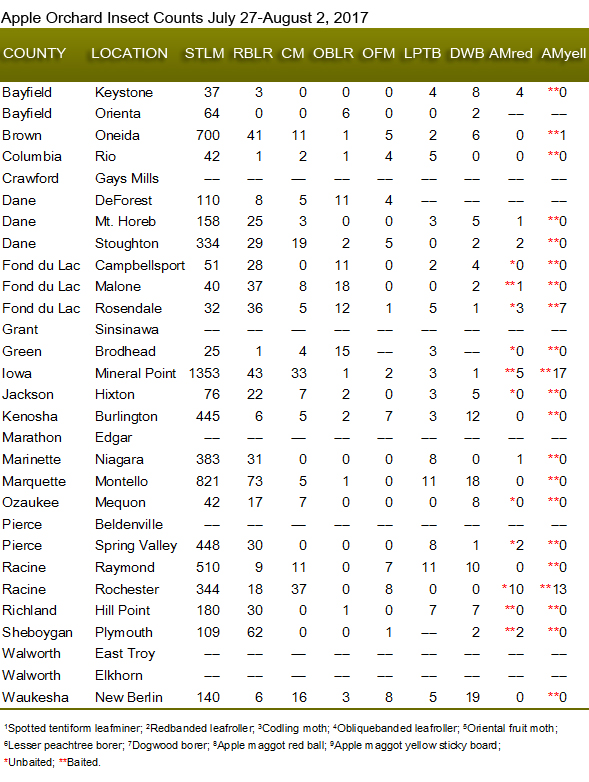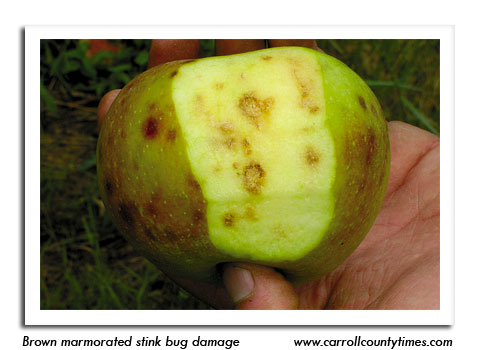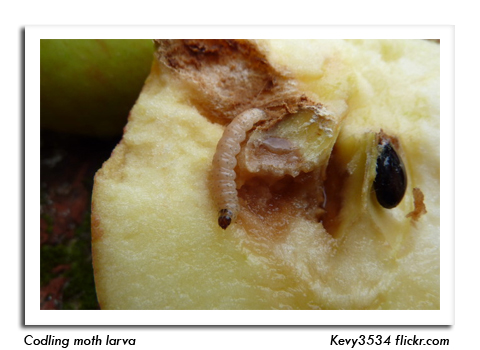
 |
|
|
Fruits
Volume 62 Number 14 Date 08/03/2017 BROWN MARMORATED STINK BUG - Nymphs from eggs deposited by overwintering generation adults were observed last week on raspberries in Brown County. Summer adults should begin appearing shortly, and the arrival of new adults could coincide with intensified movement of BMSB into orchards. For Dane County apple orchards where BMSB is known to be established, it is particularly important to be alert for late-season populations and fruit injury. Most BMSB feeding occurs at night, so the stink bugs may not be as noticeable during the day. Growers should also watch for BMSB adults near lights as an indicator of BMSB pressure. In eastern states where BMSB is a severe orchard pest, damage to apples has been misidentified as cork spot and/or bitterpit, disorders related to calcium deficiency. As levels of this pest increase sharply in Wisconsin in coming years, on-site monitoring will be the best determinant of whether or not treatments targeting BMSB are necessary. DATCP encourages growers interested in trapping for BMSB to email DATCPDARMBulletin@wi.gov to be included in next season's monitoring program. APPLE MAGGOT - Emergence is increasing and should peak soon. High counts of 17 and 13 flies per yellow sticky trap were reported from Mineral Point and Rochester, respectively, while 11 of 23 orchards registered one or more flies. Apple growers are advised to maintain traps through the first week of September and continue apple maggot sprays as long as the flies are being captured and counts exceed economic thresholds. CODLING MOTH - Substantial flights of 11-37 moths have been registered in the past week. Based on the extended flight of first-generation moths and the presence of varying sizes of CM larvae still feeding inside the fruit, this second flight will likely continue for several more weeks. Monitoring of pheromone traps is recommended until the end of the month to determine the need for late-season CM control. Spot treatment may be appropriate for blocks where trap counts remain above the economic threshold of five moths per trap per week. An insecticide application is not necessary if trap counts do not exceed this action threshold. Growers are reminded to review pre-harvest intervals before making an application. STINK BUG - Populations of native stink bugs are increasing in field crops, indicating a potential for movement into apple orchards prior to harvest. Orchard sites adjacent to uncultivated areas or with ground covers provide favored habitat. Apple growers should begin scouting fruits for the dimples or dark, irregular circular depressions typical of stink bug feeding, and flag sites with multiple depressions on the same fruit or tree. Damage by this pest is often limited to perimeter areas in the orchard and depending on the distribution of the population, spot treatment may be adequate. VINYL-SPIRAL-TREE GUARDS - Certain brands of vinyl-spiral-tree guards intended to protect young trees from rabbits, rodents and mechanical injury do not expand as the tree grows and can constrict and girdle the trees if not adjusted seasonally. Trees with severe constriction are often found with dead vascular tissue in the trunk, which can lead to infection by a range of diseases that cause tree decline. Orchard IPM Specialist John Aue reports that phomopsis and cytospora canker have been isolated this season from trunks where tree guards were used. These diseases cannot be eradicated from the tree. Orchardists, homeowners, and landscapers who use spiral guards must inspect the trunks periodically to determine if the guards need to be adjusted. -- Krista Hamilton, DATCP Entomologist 




|
|
|